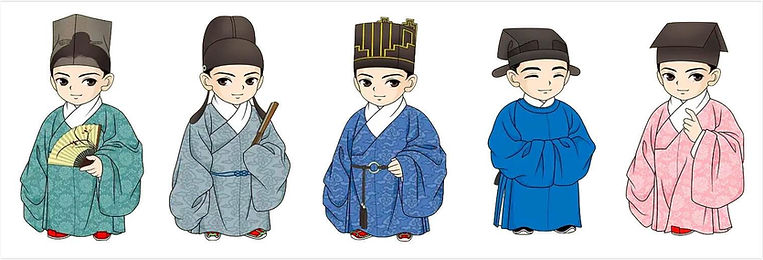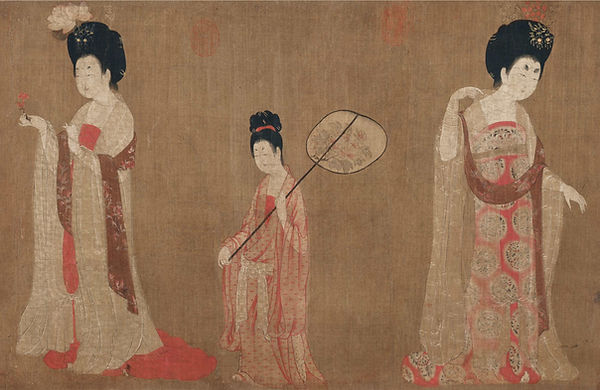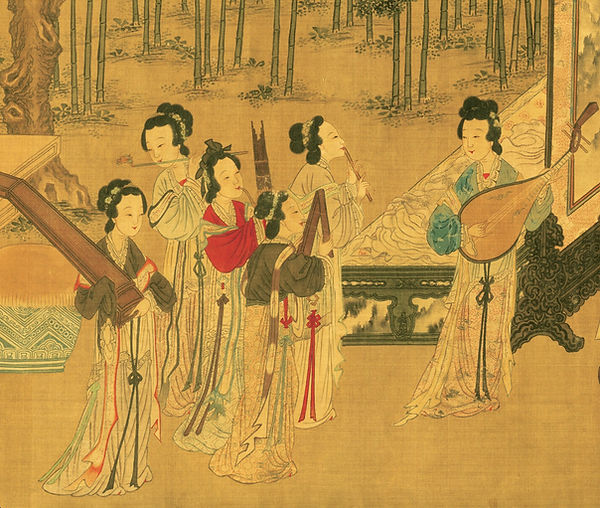Traditional Chinese Clothing and Dress — Meaning, History, Culture, and Fun Facts
Traditional Chinese clothing and dress encompass the cultural attire worn by Chinese people throughout history, from royals to civilians, including hair ornaments, outfits, jewelry, and costume accessories.
Throughout history, individuals needed to wear different outfits based on family status, age, marital situation, career, seasons, special occasions, and rites.
Each dynasty also had distinct styles and regulations concerning patterns, colors, and accessories.
Therefore, beyond their artistic and aesthetic values, traditional Chinese clothing also carry significant cultural, historical, and ritual significance.

Traditional Chinese Dresses and Hairstyles of Women of the Ming Dynasty (1368 — 1644) in the Painting "Beautiful Ladies" by Qiu Ying (about 1498–1552)
Important Elements of Chinese Clothing
Fun Facts About Traditional Chinese Clothing — Hierarchy, Color, and Pattern
Philosophy and Characteristics of Traditional Chinese Clothing
Traditional Chinese Clothing in Ancient Paintings Throughout History
Reformed Chinese Traditional Dress in Modern and Contemporary Times

Traditional Chinese Clothing in the painting "Beauties' Literary Gathering" by artist Zhou Wenju(about 907 — 975).
Important Elements of Chinese Clothing
Generally, traditional Chinese clothing includes headdresses, jewelry, pendant accessories, and outfits.
Importance of Hair and Headdresses
In ancient Chinese culture, hair was believed to be a valuable part of the whole body given by one's parents and shouldn't be cut or hurt without any reason.
Therefore, keeping and taking good care of hair was an important tradition, as well as wearing appropriate headdresses that show one's social status.
Click to Read Ranks of Terracotta Army from Hairstyle and Ornaments

Portrait of Empress Renhuai, Zhu Lian (? — 1127), the Queen of Emperor Qinzong of Song.
Many important rites in Chinese culture include headdresses and hair.
On the Coming of Age Ceremony, one needed to tie up the hair and put on Guan or Ji; at Traditional Chinese Weddings, a significant rite was to tie a strand of the new couple’s hair together, meaning they become a whole entity since then.
Click to Read More About Traditional Hair Ornaments, and Wedding Dress and Rites

Different Types of Civilians' Fabric Hats (Guan) of the Ming Dynasty (1368 — 1644) — By Xiefang Zhuren (Dong Jin)
Jewelry and Pendant
As rituals, blessings, or aesthetic decorations, they have been essential representatives of one's social status in traditional Chinese clothing culture.
Click to Read More About Chinese Jewelry and Costume Accessories
Outfit
Traditional Chinese outfits include clothes and shoes with patterns and colors that show one's social status, age, and marital situation.

Traditional Chinese Women Attire of the Tang Dynasty (618 — 907) in the Painting "Court Ladies Adorning Their Hair with Flowers" by Zhou Fang from the Tang Dynasty
Fun Facts About Traditional Chinese Clothing
Strict Hierarchy
Every Dynasty in the history of China had clothing regulations of different hierarchies and various occasions, which people of every occupation and class followed strictly.
For example, regardless of how much her husband loved her, a concubine was not allowed to wear the colors reserved exclusively for the wife; similarly, a businessman, regardless of his earnings, had limited choices of colors, fabrics, and styles.
Meanwhile, nobles or ministers should wear certain costume accessories properly, regardless of whether they like them.
Besides styles, color and pattern are the two most essential elements in this hierarchical clothing system, which have been inherited quite well throughout history.

Different Colors, Styles, and Patterns of Ming Dynasty Clothing in the Painting "Spring Morning in the Han Palace" by Qiu Ying (about 1498–1552)
Color System and Symbolism
In ancient Chinese culture, Black, White, Red, Yellow, and Cyan were believed to be the Five Orthodox Colors, which were honorable and corresponded to the Five Elements (Water, Metal, Fire, Earth, Wood) theory.
Meanwhile, specific colors were only used by royals and the ruling class, such as the exclusive use of red walls and yellow roofs in the imperial Forbidden City.
Unless the emperor primarily awards someone to wear a specific honorable color because of their exceptional accomplishments.

Clothing Colors of Wanli Emperor and Officials of Different Ranks on Xu Xianqing Huanji Tu, By Artists Yu Ren and Wu Yue in 1588 — Palace Museum
Patterns and Symbolism of Traditional Chinese Clothing
Around 2000 to 3000 years ago, the Book of Documents (Shang Shu) noted 12 patterns used for royal and noble clothing.
The colors and positions of those patterns changed slightly in different dynasties; however, their content and essence were well applied and preserved in millennium years of Chinese history.
Emperors and most honorable officials may use all of the 12 patterns; others would deduct the numbers of the patterns based on their social status.
Sun (Ri)

Moon (Yue)

Star (Xing Cheng)

Meaning people wearing these patterns are responsible for illuminating and enlightening all humankind.
Mountain (Qun Shan): Firm, Persistent, Steady.

Dragon (Long): Mysterious, Changeable, Unpredictable.

Fire (Huo): Bright and Promising.

Colorful Flower and Bird (Hua Chong): Intelligent, Write Beautiful Articles.

Algae (Zao): Emerges from the filth and stays unstained, meaning characteristic of pure and noble.

Rice (Fen Mi): To Provide and Nurture.

Axe (Fu): To cut off negative aspects and stay resolute and decisive.

A Special Ancient Embroidery (Fu): It looks like two bows back against each other, which means smart perceive, back away from evil, and face toward benign.

Tiger and Monkey (Zong Yi): A pair of ancient wine vessels in sacrifice ceremonies, meaning respect for the ancestors. The tiger represents power and dignity; the long tail monkey symbolizes wisdom, loyalty, and filial piety.

In the history of China, the utilization of these 12 patterns has been rigorous, based on social hierarchies among the ruling class.
Click to Read Chinese Traditional Clothing of Emperors and Empresses

Hongzhi Emperor in Imperial Robe with the 12 Patterns, Painted By Court Artist of the Ming Dynasty — Taipei Palace Museum
Besides those 12 patterns, images of some auspicious creatures had been used in officials' robes to show their ranks in some dynasties.
Click to Read Creatures on Robes of Officials of Qing Dynasty (1636 — 1912)
As for civilians, many other lucky ornaments are still prevalent in China, such as Magpie, red-crowned crane, plum blossom, pine, etc.
Click to Read More About Traditional Chinese Patterns and Their Cultural Meanings

Patterns of Traditional Chinese Clothing in the Painting "Court Ladies of King of Shu" by Tang Yin (1470–1524)
Philosophy and Characteristics of Chinese Clothing
-
The strict costume hierarchy follows Confucianism's essence, which highly values order, etiquette, and high moral standards.
Hence, the primary purpose of traditional Chinese clothes is to present one's social status and cover the body decently.
-
In ancient Yin Yang theory, the left is Yang, and the Right is Yin.
Hence, the right lapel (meaning the Yang suppresses the Yin) has been an essential rule in Chinese traditional clothing culture, and the left lapel is used to dress the deceased.
-
Taoism, another important philosophy school, worships freedom and follows nature. Therefore, traditional clothes are loose, smooth, and don't fetter the body.

Taoism Religion Clothing on Mural of the Yongle Palace (Built in 1247 — 1358) in Shanxi Province
Traditional Chinese Clothing in Ancient Paintings
Traditional Chinese clothing on silk paintings of the Warring States Period (403 BC — 221 BC), with flying Dragon and Phoenix creatures, are now in the Hunan Museum.


Chinese traditional clothing of the Eastern Han Dynasty (25 — 220), on the grave mural of Dahuting Tomb about the owner's banquet.

Traditional clothing of Three Kingdoms, Wei, Northern and Southern Dynasties (220 — 589) in the painting "The Ode to the Goddess of the Luo River" by artist Gu Kaizhi (348 — 405).
This is the copied version by people of the Song Dynasty (960 — 1279), preserved in the Palace Museum.

Chinese traditional clothing of the Tang Dynasty (618 — 907) in the painting "Lady Guoguo's Spring Outing", about Yang Guifei's sister Lady Guoguo and her guards, by artist Zhang Xuan (713 — 741).
This is the copied version by Emperor Huizong of Song (1082 — 1135), preserved in the Liaoning Museum.

Traditional clothing of Five Dynasties and Ten Kingdoms (907 — 979) in the painting "Night Revels of Han Xizai" by Gu Hongzhong (910 — 980).
This is the copied version by people of the Song Dynasty (960 — 1279), preserved in the Palace Museum.


Traditional clothing of the Song Dynasty (960 — 1279) in the painting "Nantang Wenhui Tu" by Zhao Chang (959 — 1016), preserved in the Palace Museum (Photo by Dongmaiying).

Traditional clothing of the Yuan Dynasty (960 — 1279) in the painting "Dongshan Sizhu Tu" by an artist of Yuan, preserved in the Palace Museum.

Traditional clothing of the Ming Dynasty (1368 — 1644) in the painting "Xu Xianqing Huanji Tu" by artists Yu Ren and Wu Yue, preserved in the Palace Museum.
.jpg)
Traditional royal clothing of the Qing Dynasty (1636 — 1912) in the painting "Yongzheng Shier Yue Xing Le Tu", about Yongzheng Emperor and his family's daily lives in the Old Summer Palace, by artist Giuseppe Castiglione, preserved in the Palace Museum.

Reformed Chinese Traditional Dress in Modern and Contemporary Times
With the fall of the feudal Qing Dynasty in 1912, some new styles of traditional clothes appeared, including Cheongsam or Qipao Dress, Tang Suit, and Zhongshan Suit or Mao Suit.
The cheongsam dress (Qipao) and Tang Suit evolved and reformed from two types of traditional clothing of the Qing Dynasty (1636 — 1912), and the Zhongshan or Mao Suit was invented and spread in the 1920s.

Reformed Traditional Chinese Clothes the Tang Suits
Recently, traditional Chinese dress became a new trend, when more people wear ancient style outfits, and more reforms and elements are added to clothing designs.
Some people prefer to follow the entire ancient clothing culture strictly, while others like to reform and develop modern-style Chinese costumes with ancient elements.
Either way, they are all part of Chinese clothing culture; because the people are the culture.

Traditional Chinese Clothing in the Painting "The Eighteen Scholars" by An Anonymous Artist from the Song Dynasty (960–1279)
You Might Also Like:
Chinese Silk — Traditions, Utilizations, Fabrics, Embroideries, Products, and Art
Chinese Jewelry — History, Tradition, Culture, and Artifact
Beautiful, Exquisite Traditional Chinese Hair Ornaments
Delicate Pendant Accessories in the History of China
Traditional Love Token — Representative of Romance and Affection
Chinese Patterns — Ultimate Introduction to Origin, History, Meaning, and Culture
Chinese Jade — Origin, History, Meaning, Culture, and Utilization
Chinese Fan — History, Classification, Utilization, Art, Culture, and Artifact
Chinese Art — Aesthetic, Characteristic, and Form
Color Symbolism in Chinese Culture
Traditional Crafts in Chinese Art
Chinese Architecture — Tradition, Characteristics, and Style
Traditional Chinese Instrument
Mysterious and Powerful Creatures in Chinese Legends
Chinese Zodiac Signs — A Comprehensive Introduction
Chinese Astrology — Three Enclosures, Four Symbols, Twenty-eight Lunar Mansions
